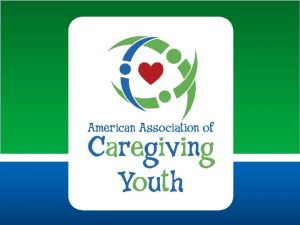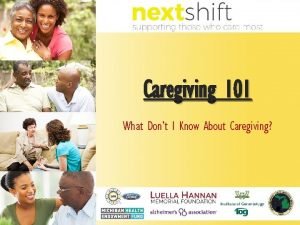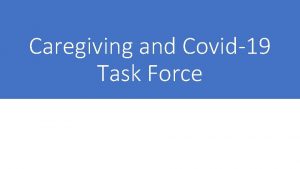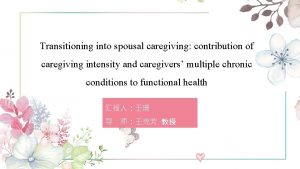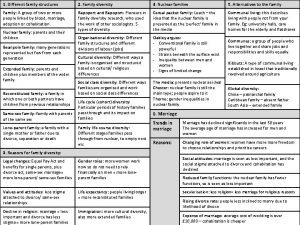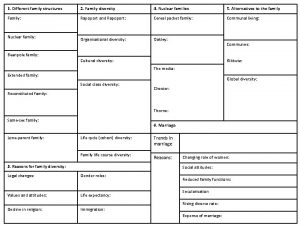Chapter 40 Family Caregiving Diversity of Family Structures













- Slides: 13

Chapter 40 Family Caregiving

Diversity of Family Structures Among Older Adults • Couples with children • Parent and child or children • Siblings • Groups of unrelated individuals • Multigenerations

Family Functions in Aging Families • Ensuring fulfillment of physical needs • Providing emotional support and comfort • Maintaining connections with family and community • Instilling a sense of meaning to life • Managing crises

Questions to Facilitate Identification of Significant Others in the Older Adult • Who checks on them regularly? • Who shops with or for them? • Who escorts them to the clinic or physician? • Who assists with or manages their problems? • Who takes care of them when they are ill? • Who helps them make decisions? • Who do they seek for emotional support?

Possible Family Roles • Decision-maker • Caregiver • Deviant • Dependent • Victim

Factors to Assess for Family Dynamics • How family members feel about each other • The manner of communication • Their attitudes, values, and beliefs • Links with organizations and the community

Family Interactions • Most elders enjoy regular contact with their children. • Most older people and their families prefer to live near but not with each other. • More than 9 of 10 elders are grandparents. • Siblings tend to develop stronger relationships in old age. • Divorce rates are low in the elderly, although increasing.

TLC Measures for Caregivers • T—training in care techniques, safe medication use, recognition of abnormalities, and available resources • L—leaving the care situation periodically to obtain respite and relaxation and maintain their normal living needs • C—caring for themselves via adequate sleep, rest, exercise, nutrition, socialization, solitude, support, financial aid, stress reduction, and health management

“Superwoman” Myth: Roles of Women Caregivers • Supportive parent • Understanding wife • Exciting lover • Interesting friend • Inspiring employee

Nursing Strategies to Assist Family Caregivers • Guide family to view situation realistically. • Provide information that assists in anticipating needs. • Assess and monitor the impact of caregiving on the total family unit. • Introduce and promote a review of care options.

Characteristics of Dysfunctional Families • Less able to fulfill the needs of their members • Rigid in roles, responsibilities, and opinions • Unable or unwilling to obtain and use help from others • Composed of members with psychopathology or behavioral disorders • Inexperienced or ineffective at managing crises • Ineffective or inappropriate with their communication and behavior

Types of Abuse • Inflicting pain or injury • Withholding food, money, medications, or care • Confinement, physical or chemical (drug) restraint • Theft or intentional mismanagement of assets • Sexual abuse

Source • Eliopoulos, C. (2005). Gerontological Nursing, (6 th ed. ). Philadelphia: Lippincott, Williams & Wilkins (ISBN 0 -7817 -4428 -8).
 Compassion fatigue vs burnout
Compassion fatigue vs burnout American association of caregiving youth
American association of caregiving youth Genetic diversity vs species diversity
Genetic diversity vs species diversity Ecosystem jigsaw activity
Ecosystem jigsaw activity Homologous structure
Homologous structure Chapter 22 plant diversity answer key
Chapter 22 plant diversity answer key Chapter 30 section 2 diversity of mammals
Chapter 30 section 2 diversity of mammals Chapter 9 cultural diversity
Chapter 9 cultural diversity Chapter 8 human resources culture and diversity
Chapter 8 human resources culture and diversity Chapter 8 study guide human resources culture and diversity
Chapter 8 study guide human resources culture and diversity Diversity and human needs and development
Diversity and human needs and development Chapter 5 biological diversity and conservation
Chapter 5 biological diversity and conservation Chapter 4 communication and cultural diversity
Chapter 4 communication and cultural diversity Chapter 30 section 1 mammalian characteristics answer key
Chapter 30 section 1 mammalian characteristics answer key

